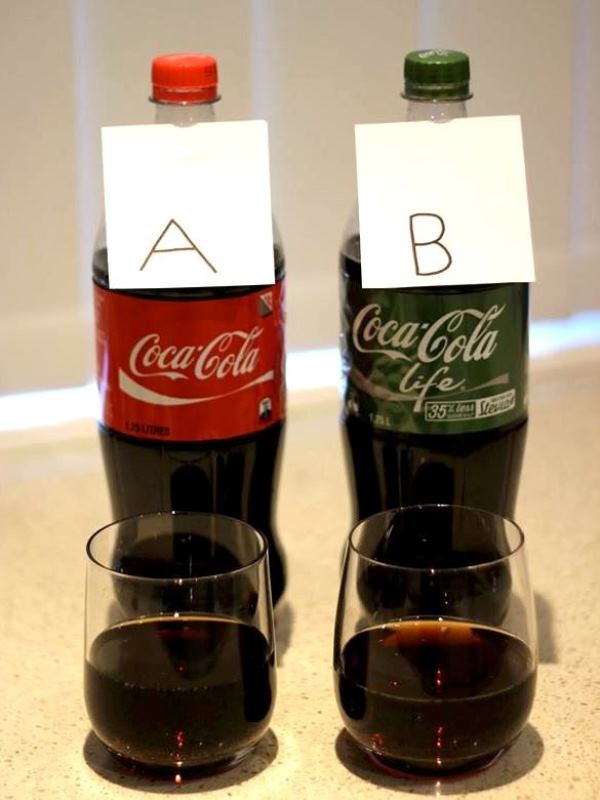Product Snapshot: Coke Life vs Coke Regular – a side by side taste test
Written by Guest reviewer
on Friday, 01 May 2015.
Tagged: artificial sweeteners, Product Snapshot, review, soft drinks, sugary drinks

Coca Cola’s variant Coke Life hit our supermarket shelves in 2015 and I’m sure you’ve seen it! Packaged in bright spring-green cans and bottles with a distinctive label that was a real contrast to the well-known red label, Coke Life brags how it contains 35 per cent less sugar and kilojoules than regular Coke but claims to preserve the classic Coke taste. Not being a Coke drinker myself, I asked a student dietitian and her cola-drinking friends to do a taste-test for me. Read on for their surprising findings.
NOTE: COKE LIFE WAS WITHDRAWN FROM THE MARKET IN 2017 WITH THE LAUNCH OF COKE NO SUGAR.
Guest post by student dietitian Daisy Coyle
What was Coke Life?
Coke Life was another Coke-branded product from the soft drink giant, the first since the launch of Coke Zero in 2006. It was released in 2015 in response to consumer demand for a soft drink that is lower in sugar/kilojoules but derived from a ‘natural’ sweetener. The reduction in sugar in Coke Life is made possible thanks to the addition of stevia, a kilojoule-free sweetener extracted from the leaves of the Stevia Rebaudiana plant.
How did it taste?
To test whether Coke Life really does taste identical to the original, I recruited four sceptical friends (who enjoy the taste of Coke) to participate in a blind taste test. In their day-to-day lives, all of the taste testers choose to drink regular Coke over the two artificially sweetened varieties Coke Zero and Diet Coke.
Each tester was given two cups, labelled A and B. Cup A contained Classic Coke and Cup B contained Coke Life. I explained the composition of the new Coke Life formula and asked them to try and pick out which cup contained the stevia-sweetened beverage.
The taste test results
- All taste testers were shocked by the similarities in taste.
- Only one tester was able to identify Coke Life due to a slight difference in aftertaste.
- The other three testers failed to identify Coke Life. They could not detect any differences between the two varieties.
- All testers said they would happily drink Coke Life again.
Pros
- A modest saving in sugar and kilojoules compared to original Coke whilst still retaining the Coke taste. The sugar content drops from 10.6 to 6.6 per cent, which is the same level as most sports drinks such as Gatorade.
- Good for people who wish to reduce their sugar intake but do not like the taste of Coke Zero and Diet Coke.
- Does not contain ‘artificial’ sweeteners acesulfame potassium 950 or aspartame 951.
- Apparently Coca Cola’s planned use of stevia will be so great that it will catapult stevia production globally as Coke Life continues its expansion.
Cons
- Coke Life still delivers a high volume of sugar when you consider a serve – 17 g of sugar from a 250 ml glass compared to 27 g from the same 250 ml glass of Regular Coke.
- A 600 ml ‘Buddy’ bottle of Coke Life contains 39 g of sugar (equivalent to 10 teaspoons) and that’s 40 per cent of your suggested maximum daily intake for sugars!! *
- A 375 ml can contains 25 g of sugar (equivalent to 6 teaspoons) which is 29 per cent of your intake!
- Coke Life still contains caffeine, a stimulant that is probably over-consumed already.
- It still contains phosphoric acid, which is harmful to teeth (it’s acidic and erodes enamel) and not good for your bones.
- In my opinion, this product is presenting itself as ‘healthy’. The striking green label and the picture of a leaf plus the clever word ‘Life’ in the brand name suggests that this product is ‘natural’ and somehow good for you. My concern is that this could encourage increased consumption i.e. an individual who previously drank one can of Coke per day decides to drink two cans of Coke Life.
- There is a danger that current Diet Coke and Coke Zero drinkers (both drinks contain zero kilojoules or Calories) could switch to Coke Life thinking it’s a ‘healthier’ green choice and subsequently increase their daily intake of sugar.
 Nutrition
Nutrition
Coke Life contains all the same ingredients (sugar, stevia, caffeine) and additives (colour, flavour, acid) as regular Coke which have attracted criticism.
|
Ingredients in Coke Life Carbonated water, sugar, colour (150d), flavour, food acid (338), caffeine, sweetener (960) |
colour (150d) = Caramel IV which is not considered harmful in the way tartrazine or erythrosine are but still has some concerns
Food acid (338) = Phosphoric acid
Sweetener (960) = Stevia
For comparison:
| Ingredients in regular Coke: Carbonated purified water, cane sugar, colour (caramel 150d), food acid (338), flavour, caffeine. |
Ingredients on a label are listed in order of "ingoing weight", largest first. Interestingly there is more flavour in Coke Life where it's listed 4th as opposed to 5th in ordinary Coke. Maybe to mask the aftertaste of stevia? We'll probably never know.
Nutrition Information Panel from 1.25 L PET bottle
Serve size: 250 mL (which is one large glass)
No of serves: 5
| Component |
Per serve - 250 mL | Per 100 mL | |
| Energy |
kJ Cal |
285 68 |
114 27 |
| Protein, g | 0 | 0 | |
| Fat | Total, g | 0 | 0 |
| Saturated, g | 0 | 0 | |
| Carbohydrate, g | 17 | 6.6 | |
| Sugars, g | 17 | 6.6 | |
| Dietary Fibre, g | 0 | 0 | |
| Sodium, mg | 2.5 | 1.0 | |
My verdict
Whilst Coke Life is a healthier alternative to regular Coke due to its reduction of sugar and kilojoules, it is a still a high sugar beverage. It contains a moderate amount of sugar and kilojoules and therefore cannot be drunk as freely as Coke Zero and Diet Coke. Whilst it may be presented as the ‘healthy’ version, it is still a fundamentally unhealthy product and should be consumed in moderation. Be wary of it.
* This is based on a suggested intake of 90 grams of sugars a day as specified by the Food Standards Code which includes BOTH added sugar as well as natural sugars from fruit and dairy. Most nutritionists suggest limiting added sugar to 50 grams a day which is 12 teaspoons. So 10 teaspoons from a 600 mL Coke Life Buddy means you’re almost at your day’s total for sugar.
Thank you to the taste testers: McCawley, Johnny, Robbie and Hayden
Thanks to Daisy Coyle, student dietitian, for writing this Review.
Foodwatch
The Good Stuff
The Boring Stuff
© 2025 Foodwatch Australia. All rights reserved
Website by Joomstore eCommerce





